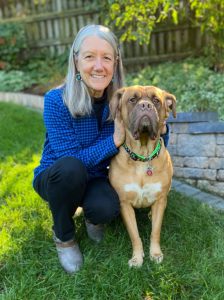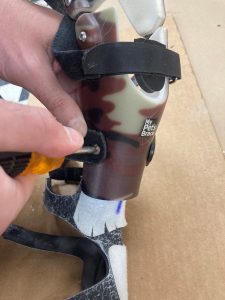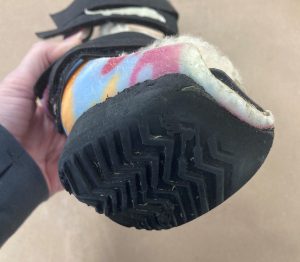
TERRY LACKMEYER
Customer Service Representative
We designed our braces to last for years. The outer shell is a co-polypropylene material, the same type of medical-grade material used in human braces. The lining is a closed-cell foam that does not absorb moisture or bacteria. All the screws and buckles are stainless steel. Everything used in the making of the brace is waterproof.
While the outer shell, lining, and screws can go on for years, other parts such as the straps, pads, as well as the soles of hock and carpal braces, will need replacing periodically. How often these parts need replacing is something we have no way of predicting. The wear of these items depends on many factors such as the activity level of the dog, the type of surface they walk on with the carpal or hock brace, the surfaces they lay on with the brace, and how much they are in water.
The good news is we try to make everything as easy as possible to replace so that we can send parts to you, and you can replace them yourself. However, we tend to get repeated questions about maintenance and part replacement, so we just wanted to give a few pointers on those things.
General Cleaning and Maintenance
Braces take a lot of abuse, and they are designed to withstand that. However, basic care will go a long way in keeping the brace comfortable for your pet. Like anything else, the brace will get dirty – sometimes, VERY dirty. Every few days take a good look at the brace and see if it needs cleaning.
Braces are waterproof and designed to withstand being in water. If the brace looks dirty or smells, give it a wash. Wash it with antibacterial soap and a washcloth. If it gets really dirty, clean it using your regular hand or dishwashing soap.
Be sure to check the Velcro for hair. If clogged with dog hair, the Velcro will not stick as well, and this will affect the brace fit. When you get a brace, we supply a wire brush to help remove the hair. Be sure to use the wire brush only on the coarse portion of the Velcro, not the fuzzy portion as it will rip up the fuzzy portion. To remove hair, brush in one direction over the coarse portion of the Velcro with the wire brush. It will pull the hair out. If the fuzzy portion has hair on it, try using a lint roller or tape on it. That should remove the hair without harming the Velcro.

How often straps need replacing depends on numerous factors so there is no way to predict how frequently that will occur. If the elastic straps start to lose elasticity, it’s time to replace them. If they start to tear or fray, it’s time to replace them. Remember, those parts are covered under the warranty and there is no charge to replace them for the first four months that you have the brace. Just give us a call and we can send the parts to you in the mail.
The screw that you see attaching the strap is called a combination head screw, which means you can use either a flathead or Phillips screwdriver to remove it. Remove the old strap, put the new one on, then do the reverse to tighten the screw.
Many people contact us when trying to replace the straps because they cannot get the screw out or it “just spins.” We use a liquid thread locker to help keep the screws secure, so sometimes it’s difficult to get the screw to let go. If this happens, remove the little round circle sticker/dust cover from the inside of the brace, covering the back of the screw. Insert a flathead screwdriver to hold the back of the screw in place and use a separate screwdriver on the front/outside of the brace to loosen the screw.
On really small braces, we use a screw that needs an Allen wrench. Many people have Allen wrenches in their toolbox, but we’ll send one along with the new strap. Just follow the same technique to replace the strap as described above.
Adding Pads
Sometimes people do not need to order a strap, only the pad that goes on it. Getting that pad on the strap can be tricky as it fits snuggly. The easiest way to do this is to fold the end of the strap in half and put it through the loop of the pad. Once the pad is on the strap, flatten or open the strap, then gently slide the pad into position.
Replacing the Suspension Sleeve
Knee braces have a suspension sleeve. This is the neoprene part that wraps around the dog’s hock and attaches to the inside of the brace. This part gets quite a bit of wear and tear and often needs replacing. People are surprised to learn that this piece is held in place with Velcro, extraordinarily strong Velcro.
When the new suspension sleeve arrives, remove the old suspension sleeve by pulling it out of the brace. That Velcro really holds on sometimes so you may need to really pull hard to get it out. Then, align the marks of the new suspension sleeve with the mark on the brace edge and firmly press it in place.

Sole Replacement
People wonder how often to replace the sole on hock or carpal braces. This is another area where there is no fixed rule. How quickly the sole wears depend on the activity level of the dog and the type of terrain over which they travel. If your dog walks mostly on concrete or asphalt, the sole is going to wear down much quicker than that of a dog that spends all of their time walking on grass. Likewise, a dog that is constantly moving and active, even on softer terrain, is going to wear down the sole much quicker than a dog that spends much of their day lounging.
Just like with a shoe, when the tread of the sole starts wearing off, it is time to have the sole replaced. If you are lucky enough to have a good shoe repair store in your area, they can replace the sole of the brace. If not, you need to send the brace back to us to have it re-soled.
It is important not to let the sole wear down so far that it exposes the plastic portion of the brace, as the exposed plastic makes the sole replacement much more labor intensive and the worn plastic is not good for the brace. Please have it replaced or send it back to us before that happens.
Taking the time to maintain and care for the brace will make it much more comfortable for your dog to wear and that will help both of you to have a happier, healthier life.
